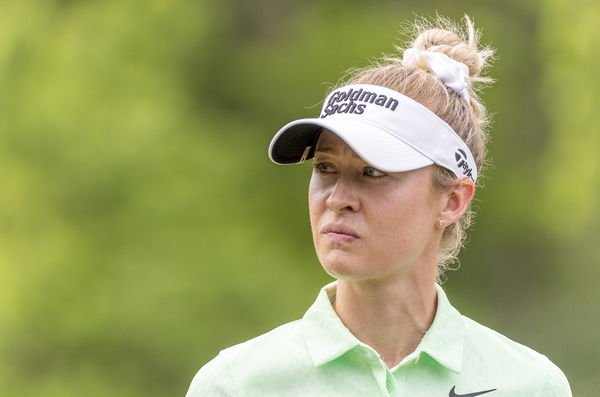Is Nelly Korda’s Historic Effort Going In Vain? Dark Reality Buries Dominant Women’s Golf Narrative

Follow Us

USA Today via Reuters
Apr 18, 2024; The Woodlands, Texas, USA; Nelly Korda (USA) walks up to the 17th tee during the first round of The Chevron Championship golf tournament. Mandatory Credit: Thomas Shea-USA TODAY Sports
Nelly Korda’s historic triumph attracted enough eyeballs. Comparisons with Caitlyn Clark, in terms of being the cynosure of her sport, galore. Her Solheim Cup captain even called for more action on the world No. 1’s part. Korda herself was more focused on inspiring upcoming stars, the young dreamers.
It’s also why Lexi Thompson was content despite missing the cut at the Shriners Children’s Open, a PGA Tour event. These acts are indeed inspiring, but the trouble is that the LPGA hopefuls are struggling financially. It’s not a question of grind or greet, but at the end of the day, it boils down to mere numbers on an expense sheet: the credit bills and debts.
How much money does it take to be successful?
ADVERTISEMENT
Article continues below this ad
Hannah Gregg, an LPGA hopeful, gave an insight into how much it takes—only financially—to keep the dream alive. Currently playing at LET, the 29-year-old offered a rundown of how much a week of professional golf costs. Gregg had to spend $3672 including flight charges, food, caddie expenses, work visa, gas, and entry fee. That’s without hotel and car charges, by the way.
Gregg entered the country down under to play two events. First the Women’s New South Wells pen, and then the Australian Women’s Classic. The University of Nevada alum made the cut at the former, finishing 54th. She earned $1244, almost a third of what she spent there. Also, add to that the tax, which roughly stands at 35%. Australia has a strict tax rule; last year, Talor Gooch had to pay 47.5% of his $4 million winner’s paycheck in taxes.
Trending

Despite Being Shown the Exit Door, Rickie Fowler Becomes the Bigger Person With Latest Gesture for Ex-Sponsor
May 07, 2024 04:04 PM EDT

PGA Tour Suffers a Major Setback as a Scottie Scheffler Disappointment Hits the 2024 Wells Fargo Championship
May 08, 2024 02:30 PM EDT

With 10 Days Left For PGA Championship, Scottie Scheffler’s Future Thrown Into Disarray by New Report
May 06, 2024 05:16 PM EDT

Nelly Korda Manages to Charm Paige Spiranac as ‘Hottest’ Met Gala Look Stuns the Golf World
May 07, 2024 04:11 AM EDT

‘Pretty S**t’: Tiger Woods Fails to Save Sun Day Red for Fans, Exclusive Brand Faces Brutal Reality Check
May 06, 2024 02:31 AM EDT
Get instantly notified of the hottest Golf stories via Google! Click on Follow Us and Tap the Blue Star.

Follow Us
The next event was canceled, and there was no money involved. So, Gregg didn’t actually ‘make’ any money. Rather, she had to burn her pockets. Also, the LET pro further revealed her visa will be valid only for three months.
Expenses of my first week on Ladies European Tour:
Flights: $2600
Work Visa: $350
Food: $377
Caddie: $0 because I have an amazing Fiancé
Hotel: $0 because @GregChalmersPGA sorted me host housing for the week! 🙌
Rental Car: +0 because the Tour Tee guys GAVE me their car 😭🫶…— Hannah Gregg (@hannahbggg) April 26, 2024
Summing up, Gregg said that with the same expense, she has to finish within the top 20 to, at least, see some profit. Fortunately, she made the cut. Those who didn’t make the cut had to leave without earning any money. That’s even true for the LPGA Tour. In fact, the job is much harder, as the very best are always competing against the very best.
Life at LPGA is no different
While Gregg covered the part for LET, the story at the LPGA Tour is pretty similar. As of now, in golf, only eight Signature events are on the PGA Tour, and all 14 events in LIV Golf offer guaranteed money for the entire field. Augusta National has been offering $10,000 to players who miss the cut. This year’s Chevron championship, too, had $10,000 reserved for players who failed to book a Saturday berth.
But that’s not the case for any regular LPGA Tour events. Including the flight charges, caddie expenses, and travel, an LPGA Pro often has to burn their pocket to pay for all of the expenses. During international swing events, managing finances is doubly harder.

via Imago
(170917) — EVIAN-LES-BAINS, Sept. 17, 2017 — Lydia Ko of New Zealand prepares to play a shot during the second round of the Evian Championship on Sept. 16, 2017 in Evian-les-Bains, France. ) (SP)FRANCE-EVIAN-GOLF CHAMPIONSHIP-SECOND ROUND AlainxGrosclaude PUBLICATIONxNOTxINxCHN
LPGA Tour pro Jenny Shin, while answering a question during a Q&A session, wrote, “If a player misses the cut more than half of the season, they are losing money.” The confession coming from a player with a regular membership card is even more staggering. The situation is harder even for those who are on conditional status.
ADVERTISEMENT
Article continues below this ad
The winner’s paycheck has increased, but not the others’
In the last few seasons, the LPGA Tour has witnessed a massive bump in prize money—78.6%, to be precise—since 2019. Chevron most recently extended their partnership with LPGA until 2029, elevating the purse to $7.9 million. The five majors totaled $23 million in 2021. This year, it is slated to reach $45.4 million. It can double before the year ends, as USGA and R&A are likely to follow in Chevron’s footsteps, pumping in a few more millions.
Not just majors; the trend is evident in regular events as well. 11 tournaments have $3 million or more on offer this season, up from only five last year. JM Eagle, which doubled its prize last year, has injected $750,000 more this year. The season-ending CME Group Tour Championship winner stands to pocket $4 million, a first in the LPGA Tour’s history.
ADVERTISEMENT
Article continues below this ad
But for the players barely making the cut or languishing at the bottom, nothing really matters. After paying the caddie, hotel charges, and travel expenses—all of which have to be borne by the player—an LPGA pro can still lose money even after making the cut, Cheyenne Knight told Golfweek.
Amy Olson, a veteran of ten years, said, “I’ve seen so many players quit due to finances and not due to lack of talent. You have to have a tour that provides sustainability for that next generation, and we don’t have that right now.” Sustainability is crucial for Kordas, Kos, and Zhangs to rise to the top. An increased purse with more heavy-weight sponsors is surely a good omen for women’s golf. But unless that money funds the dreams of upcoming players, churning out new home-grown stars will remain a pipe dream.
ADVERTISEMENT
Edited by:

Sheldon Pereira
ADVERTISEMENT
ADVERTISEMENT

